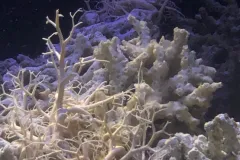Brittle Star Splits

Splitting your body in two is a feat only a few animals can complete, and now basket stars are among them. Aquarists at the St. Lucie County Aquarium in Ft. Pierce, Florida watched as one of their deep-water basket sea stars, which is living in the Smithsonian Marine Ecosystems Exhibit, split its body in two, and then, surprisingly, each half proceeded to regrow into a fully functioning basket star—a first for this particular species.
“This species has been observed by thousands of scuba-diving scientists and amateurs over many years, and none have apparently reported asexual reproduction,” Dave Pawson, a retired senior scientist at the Smithsonian’s National Museum of Natural History, said. “I am astonished that it can successfully reproduce by dividing, even in an aquarium,” said Pawson, noting that stress from moving from the wild into the aquarium may have played a role in the split.
Commonly found throughout the Caribbean, Astrophyton muricatum has a more elaborate appearance than a typical five-armed brittle star. From a central, circular body disc their five main arms branch into several curled offshoots, much like a tree. This sprawled anatomy helps them capture their favorite meal—as zooplankton morsels drift by, they can snag them with their many outstretched arm branches.
With an ornate beauty, the basket star’s sex life seemed comparatively predictable. Like many ocean dwellers, males and females simultaneously spew their eggs and sperm into the water column. It’s a high-stakes bet that chance will unite at least a fraction of the eggs and sperm in fertilization. Like in humans, the sexual reproduction of sea stars involves the joining of genes from a male and a female.
But some sea stars and brittle stars are able to duplicate themselves, a process called asexual reproduction. We now know that A. muricatum is one of those species. Compared to most other animals, sea stars and brittle stars are stellar when it comes to rebuilding their bodies. Losing an arm isn’t an issue for these animals—they simply grow it back. Often, they will even purposefully lose an arm in an attempt to distract, and escape from, a predator. The process of regrowing a limb is called regeneration, and when sea stars and brittle stars duplicate themselves it’s the same process, just a bit more involved.
These animals undergo asexual reproduction in one of two ways. In this event, A. muricatum split its body down the center in a process called fission, but some sea stars (like the comet star) can regrow an entire body from a single chopped off arm.
When the body of a sea star or brittle star splits, it initially covers the exposed wound with a protective layer of specialized skin cells. With the wound covered, it can then attend to the rebuilding process, which is slightly different from species to species. In general, regeneration involves the transformation of cells. Each cell in the body has a given role or function—a muscle cell has the machinery to contract, a nerve cell the ability to conduct electrical signals. When a sea star is in the process of regeneration these specialized cells lose their unique characteristics. Most of this “dedifferentiation” occurs close to the wound or split but some cells throughout the body also go through the process. They then migrate toward the growing part of the body.
In a coordinated process that is still somewhat of a mystery to scientists, the unspecialized cells then reprogram themselves and build out the missing part of the body. Regeneration can take months in some species, and this is why it is common to see sea stars or brittle stars with partially grown arms.
Of the 2,000 species of brittle stars—the group that the basket star belongs to—35 are known to duplicate in this manner. But unlike these other species that are usually less than an inch (25 millimeters) in length, A. muricatum can be over a yard in diameter, making this split one for the record books.


